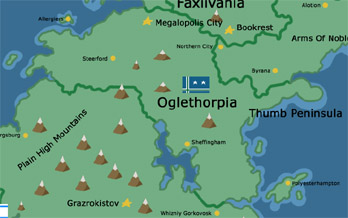Oglethorpia
The Bureaucratic States of Oglethorpia -- also known simply as Oglethorpia, and less often the Bureaucratic States -- is a constitutional federal republic located in the center of The Plain Flat Plains. To Oglethorpia's southwest is Stanigramistan, with Swedeway, Faxilvania and Kingsford forming the country's northeastern border. These compose the sum of Oglethorpia's land borders, with the rest of the nation flanked by seas. It is a remarkably peaceful nation, even over the course of its four century history.
| |||||
| Motto: Quite clearly concise | |||||
| Anthem: The Ballad of Oglethorpia | |||||
| Animal: Great Green Whale | |||||
|
\Here be the PENDING Map/ | |||||
| Capital | Megalopolis City | ||||
| Largest city | Megalopolis City | ||||
| Official languages | None; English de facto | ||||
| Government | Constitutional federal republic Hughgo I. Gurkemann Walter R. Stewell Nathan E. Minor | ||||
| Unification | 23 April X573 | ||||
| Area • Total • Land • Water |
3,150,000 km² 3,128,548 km² 21,452 km² | ||||
| Population • X976 census • Density |
1.874 billion 599/km² | ||||
| GDP • Total • Per capita |
ρ69 trillion ρ37,030 | ||||
| Currency | Parcel (ρ)
| ||||
| Time zone | UTC 000 | ||||
| Internet TLD | .ogl | ||||
| Calling code | +000
| ||||
The Bureaucratic States is known internationally primarily for its culture, sports achievements, advancements in technology and exquisite environment.
Contents
History
Main article: History of Oglethorpia
The lands that would become Oglethorpia were once its predecessor state, the Commonwealth of Oglethorpia. The Commonwealth reflected the desire of the various townships to preserve their own power. This shortlived government was replaced in X573, with the growing tide of nationalism eventually instigating the creation of a more formal, centralized government in what would become the Bureaucratic States of Oglethorpia.
Government and politics
Oglethorpia's federal and municipal governments are quite strong, due to the lack of state-level administration. Hence, its typical tasks are delegated to the other two levels of government.
Federal government
The federal government of Oglethorpia has three branches; these are the
Municipal government
Oglethorpia's executive branch consists of three heads of state; a premier, president and prime minister. Currently these positions are held by Hughgo I. Gurkemann, Walter R. Stewell and Nathan E. Minor, respectively. While these roles are characteristic of an oligarchical structured government, all the positions are elected and serve to better represent the various parties within the country.
Legislative
Oglethorpia's Legislative Convergence is a bicameral lawmaking institution, comprised of the House of Homosapiens and the House of Human Beings. Each house is made up of 900 seats, the former representing the administrative divisions by population and the latter equally. Members of both houses are simply called representatives and are elected by the citizens of the country's administrative divisions for five years.
Judicial
The judicial branch of the Oglethorpian government defines the power of both the executive and legislative in matters of dispute. This branch of government saw major expansion after the clash between the executive and Parliament in the Oglethorpian Parliamentary Conflict. Since then, the judicial has done little to change the existing checks and balances within government. It is the Lower Courts that see the most action; as such, Upper and Middle Court appointments are seldom paid attention.
Military
Main article: Bureaucratic States Aggregated Armed Forces
The armed forces of Oglethorpia are commonly known as the Aggregated Armed Forces, and officially, as the Bureaucratic States Aggregated Armed Forces. The Executive Office collectively holds the title Commander-in-Chief (in actuality, Commanders-in-Chief) during times of war; during peacetime, mobilization of the military is handled by the Defense Bureau.
The principal purpose of the Aggregated Armed Forces is to preserve the security of the Bureaucratic States; involvement abroad is exceptionally rare and has only ever been on a small scale in recent history. While the Aggregated Navy acts as the primary line of defense, Oglethorpia also maintains a standing army and air force for dire situations.
The active duty personnel count for all branches of the military stands at 9,370,000. Both the Aggregated Army and Aggregated Air Force reported strengths of 2,811,000, and the Aggregated Navy a strength of 3,279,500. The Aggregated Armed Forces also has a tactical nuclear strike capability, shared between the Aggregated Air Force and Navy.
While the Bureaucratic States Aggregated Armed Forces are exceptionally well-funded, receiving 3% of the nation's GDP, their force projection capabilities are not as strong as that of other countries due to the military's primarily defensive role. This defensive stance is evident in the fact that Oglethorpia's Aggregated Armed Forces have seen little to no conflict in the past half-century. Recently, this has created a rift between politicians seeking to preserve the military as it stands, and those that wish to cut defense spending.
Oglethorpia also has an all-volunteer Regional Militia, with a reserve personnel count of 2,255,270 (or roughly 1/10th of a percent of the population). In modern times, the Regional Militia helps to assist in emergency situations.
Administrative divisions
Presently, Oglethorpia has ten administrative divisions based on the areas surrounding the major cities of the nation.
Geography and climate
</div>Oglethorpia resides north of the Stanigramistan, shares a border with Swedeway to the north, and borders with Kingsford and Faxilvania in the east. It has coasts on both the Tar Pin Sea and the Brine Sea; to the north and south respectively.
Cities
Megalopolis City, the capital is located in the northwestern corner of the nation. Steerford, Oglethorpia's second largest city, is near the western border next to Stanigramistan. Polyesterhampton, Oglethorpia's primary port, is located on a large flat island offshore in the southwestern corner of the country.
Economy
Pursuing an economic policy favorable to its own corporations, Oglethorpia has been able to foster and maintain a formidible trade surplus of over 300 billion Parcels. The fluctuation of the unemployment rate has been stabilized by the government's adjustment of bureaucratic measures, forcing corporations to hire on workers when the unemployment pool grows too large.
The policy has yet to yield a forced layoff, but some economists predict that will soon change. Recently, the government has made these adjustments designed to control the pool of prospective workers much more gradual to prevent the need to employ the agenda in reverse.
Transportation
Oglethorpia has three primary means of transportation. They are;
- Airway (air)
- Maglev (rail)
- Highexpressturnpikeway (road)
With the centrilization of the population into three distinct metropolitan areas, large international airports have sprung up providing passenger and cargo service to both near and far destinations. Nearby nations such as Faxilvania and Kingsford maintain maglev connections to Oglethorpia, which has proven a cheap alternative to air travel in both passenger and cargo transportation.
The Oglethorpian Highexpressturnpikeway connects Steerford to the capital, and from there goes to the border, branching out and ending at the destinations of Bookrest, Faxilvania and Northern City, Kingsford. Lately, the popularity and simplicity of maglev travel has seen a decline in the popularity of the five-lane each way road system.
Polyesterhampton serves as Oglethorpia's only and largest seaport, but is seldom used in comparison with air, rail and road figures individually.
Demographics
Languages
An estimated 97% of Oglethorpians speak English. Due to the prevalence of the language across the nation, the government's use of it is de facto despite no official preference for one language. Still, nearly all Oglethorpian government documents from the past four centuries have been in English, testament to its widespread use in the country over the years.
Most English speakers in the country utilize a dialect particular to Oglethorpia, known as Oglethorpian English. It is marked by its uniform spelling scheme and simplified pronunciation.
See also: Oglethorpian English
Education
Highly prized within Oglethorpia, education is largely a government managed affair. The federal government maintains requirements for elementary school, middle school and secondary school cirriculum, with the municipal government in charge of staffing them. In the Bureaucratic States education is free up through secondary school; still, its universities are subsidized helping to alleviate tuition costs.
Oglethorpia's universities are well regarded undergraduate and graduate schools, the oldest of which dating back four centuries. Oglethorpian universities are known for their large government funds they recieve and their strict focus on education.
Culture
Sports
By far the sport that captures the nation's attention is football. While the country has a healthy domestic league, Oglethorpians are far more interested in the World Cup scene, despite the recent efforts of the national squad to regain the level of success that the program once enjoyed.
Entertainment
Oglethorpians are easily entertained, and primarily by television. Any given intersection in the downtown area of the capital city is saturated with television screens, showcasing the extent of the Oglethorpian indulgence in consumerism. Rising automobile accident rates in the metropolitan areas of the nation's large cities are testament to how distracting advertising has become.
International Organizations
The Bureaucratic States of Oglethorpia is a member of the following organizations;
- Ur Trade Pact (defunct)
- Strategic Plains Alliance (defunct)
- The Plains League



